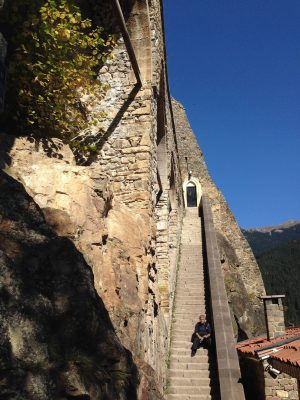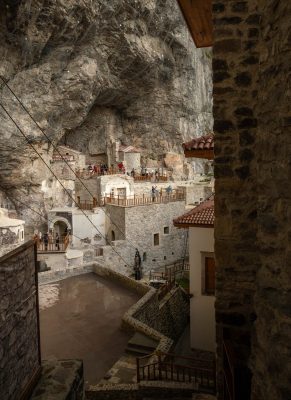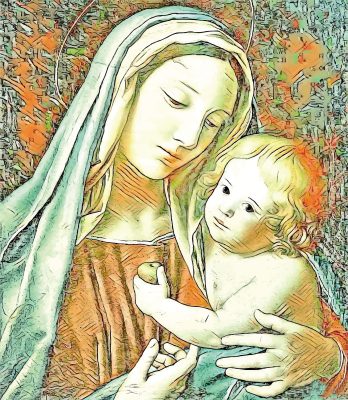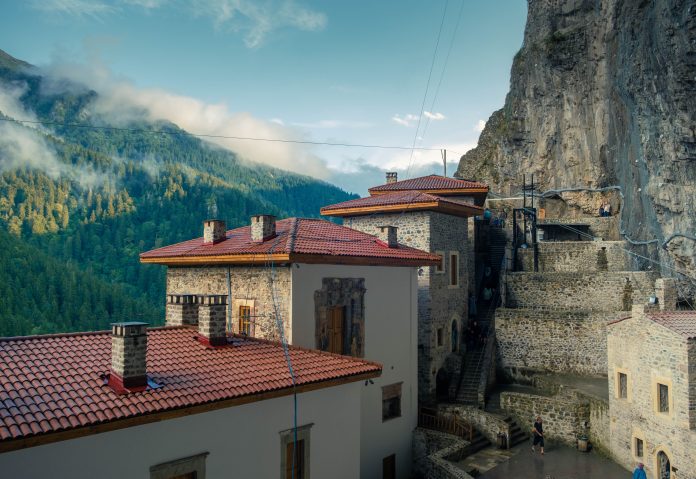The Sumela Monastery is a famous monastery that locates in Turkey. Built in the 4th Century, 386 AD to be precise, it is one of the oldest monasteries within the realm of Christianity.
The monastery boasts of amazing architecture built along the Altmdere Valley in Turkey. A monk from Athens named Barnabas laid the foundation of this complex monastery.
Considered as one of the most significant symbols of the Christian religion, this monastery locates in a country dominated by Islam. The reason behind this is essentially geo-political.
Let us find out how.
Table of Contents
Sumela Monastery: Why is A Greek Monastery in Turkey?
Though the monastery symbolizes Christianity, it is located in Turkey because of the Treaty of Lausanne. This name of the treaty reflects the fact that it was signed in Lausanne (Switzerland) in 1923.
The two parties between whom this treaty was signed were Turkey on one side and France, Greece, Japan, Italy, Romania, and Britain on the other. Without dwelling too much on the subject matter of the treaty, it was signed as an acknowledgment of the state of turkey.
Hence, this is how a monastery that is Greek orthodox in origin came to be situated in Turkey.
Origin of Sumela Monastery Turkey
13th Century
Going by famous folklore, the Sumela Monastery was built by two monks from Athens, Barnabas, and Sophronius. Though a humble structure back in 386 AD, the monastery received immense monetary contributions in the 13th Century.
Consequently, the Sumela Monastery was expanded to become its current structure. These donations came from the renowned Alexios III of the Komnenian Empire of Trabzon.
18th Century
While the Sumela Monastery Turkey expanded in the 13th Century, it became only richer in the 18th Century. This was when the monastery underwent renovations, gradually leading to the spectacular structure one can witness today.
During the 18th Century, special efforts were made towards beautification inside Sumela Monastery. Frescoes were painted on the inner walls of the monastery to enhance its appeal.
19th Century
Though the monastery witnessed architectural revisions in the 18th Century, it entered a “golden era” in the 19th Century. With the architectural enhancements received from Greek Orthodox communities across Anatolia (part of contemporary Turkey), the monastery has already become a splendid sight.
Needless to say, this attracted thousands of tourists worldwide in the 19th Century. Built almost 1200 meters above sea level, the monastery swiftly became famous as a must-visit sight in Turkey.
This contributed to tourism growth in Turkey, hence the phrase “Golden Era of Sumela Monastery.”

How to reach Sumela Monastery Turkey
Due to the monastery’s fame since times unknown, thousands of people aspire to travel to Sumela Monastery every year. Do you toom want to know how to reach Sumela Monastery Turkey? We will update you with all the details you need.
So, here is how you can reach the monastery:
- First, travel to the city of Trabzon (also spelled Trabson) in Turkey.
- Then get a ticket for a minibus ride to the Sumela Monastery.
That’s it! So, next time you plan a trip, make sure it’s to this breathtaking monastery in the crevices of Altmdere Valley.
Not just this, apart from the monastery, there are numerous other sights in Trabzon that you can visit. Some of these are Ataturk Pavillion, Zagnos Valley Park, Gulbahar Hatun Mosque, and many more.
What is Inside Sumela Monastery?
The original structure of the monastery comprised a library, a sacred spring, and several chapels. However, because Turkey has high earthquake rate, many parts of the structure eroded over the years.
As a result of repeated restoration projects, workers have to repetitively remove a lot of debris and rubble. In fact, after a massive earthquake, people had to remove 4000 tones of rubble from Sumela Monastery.
These restoration projects have been funded by the Turkey government, for whom the tourism aspect of the structure is of prime importance. As the monastery is venerated particularly among Greeks, the monastery attracts hundreds of Greek tourists annually.
A Monastery That’s Suspended in Air
Apart from being an architectural marvel, the monastery also features in UNESCO’s list of World Heritage Sites. A monastery of the holy trinity, located at a cliff top in Central Greece, this structure practically floats in the air.
Perched at roughly 1200 meters, the monastery was built along with 24 other monasteries in Meteora. Meteora is a rock formation in Greece that means “suspended in the air .”However, owing to the geo-political issues mentioned earlier, it is located in what we call Turkey today.
About the architecture of Sumela Monastery
As olden Greece was wrapped in wars, this monastery was where monks would seek refuge when danger loomed over. The main cathedral of the monastery was constructed in the 15th Century. In 1741, two monks decorated the inner walls and ceilings with frescoes.
These frescoes are a true reflection of the post-Byzantine Empire. One can see frescoes of many eminent Greek saints adorning the interiors of the monastery.
However, sadly, various parts of the monastery were subjected to loot and plunder during World War II when the Germans invaded this part. Unfortunately, this led to the loss of priceless relics.
One would be surprised to know that since the monastery is nestled on a clifftop, there were few ways to reach it in the olden days. People could either be airlifted in a basket or they could climb up ladders that were constructed along the periphery of the cliff.
Fortunately, over the years, roads, tunnels, and staircases have been carved out of the cliff for the convenience of tourists.
An architectural marvel, this monastery has been showcased in many famous films. You can catch glimpses of the monastery are the James Bond and Tinton movies.

Interesting folklore behind Sumela Monastery origin
There is an interesting folklore that narrates how the monastery came into existence. It is said that two Athenian priests had the same dream. The priests got visions of an icon that had to be placed at a specific mountain spot.
After waking up, when both the priests followed the way they had dreamt of, they ended up at the cliff top where the monastery was located. Though both priests followed their own separate ways, they arrived at the same place.
Once they met and shared their respective dreams, both priests set up camp at the cliff top. Then, they began trailing the cliff and the surrounding caves. Inside one of these caves, they found an icon made by Saint Lucas.
At this same spot, they began constructing a church. This church exists within the premises of the monastery to date. The construction required rock formations to built and locates within one of the caves inside the monastery.
The icons on the outside have dotted decoration with intricate frescoes on the inside. If you venture deep inside Sumela Monastery, you can see the makeshift room where both priests lived.
In the 13th Century, when the monastery was expanding, they added many structures to it. For instance, the foundation of the Bell Tower and the kitchen happened during this time.
After the Ottoman conquered Trabzon in 1461, the monastery began to bloom. The development project required the Sultan’s approval. To show his excitement about building the entire compound, the Sultan even made monetary contributions.
Hence, even though the Greeks built it during their inhabitation in the region back then, the government of Turkey took over later.
2016-19: The lull period of Sumela Monastery
As mentioned earlier, Trabzon is highly susceptible to earthquakes of very high magnitudes. When the situation got particularly rough in 2016, there were incidents of massive rocks falling from the cliffs on the tops of the monastery.
This was when the government took measures to mitigate the risks the monastery could incur because of the natural calamities. From 2016 to 2019, the monastery did not allow tourists. Workers covered the cliffs with heavy netting during this period to prevent rocks from falling on the monastery.
After three rigorous years of renovation, the monastery finally opened again in 2019.
Sumela Monastery: A symbol of ruins
Though the monastery holds immense beauty, it also cries of ruins and abandonment that it has witnessed since its inception. Due to the repeated earthquakes in the 21st Century, the Bell Tower and the main library of the monastery turned into heaps of debris.
Also, owing to the political clashes between Greece and Turkey in 1923, the Greeks abandoned the surrounding residential areas of the monastery.
The Frescoes within Sumela Monastery
As mentioned, the monastery has frescoes painted all over its insides. While some of these frescoes portray scenes from the holy Bible, other frescoes depict the various rulers that the ancient monastery witnessed.
Captured below are some of the frescoes that one can witness:
Our Lady of the Sign
Our Lady is another depiction of Virgin Mary. In this icon, her facing looks directly onto the onlookers. Her hands are in orans position. Also, Jesus is visible in this icon as a kid upon Virgin Mary’s bosom.
In the fresco painted inside Sumela Monastery Virgin Mary and Jesus have similar postures. There is halo behind both Virgin Mary and Jesus. Halos in paintings and murals symbolize divinity and holiness.
Hodegetria Fresco
The word “Hodgeteria” means guiding spirit. This fresco shows Jesus Christ laying on Virgin Mary’s left shoulder. There is a throne with Virgin Mary sitting on it. Apart from Jesus and Virgin Mary, you can also see the archangels, Michael and Gabriel, on either side of the Virgin Mary.
Christ Pantocrator Fresco
This fresco shows Christ making a gesture of benediction with his right hand. Also, he holds the holy Bible in his left hand. The three fingers on his right hand symbolize that there is only one God, and the other two fingers portray the dual image of Jesus as God and human.
The ascent of Jesus Christ into heaven
As Jesus was an incarnation of the almighty as a human on Earth, people believe that he did not die. Instead, he ascended to heaven. This ascension reflects through fresco wherein Christ comes out of his casket in heaven as a light beam.
Prophet Jonah Fresco
According to a famous story from the Bible, Jonah had escaped God, after which God appointed a gigantic fish to kill Jonah. Once the fish caught Jonah, it engulfed him in its mouth.
Jonah remained stuck in the mouth of the great fish for 3 consecutive days and nights. After much pleading and begging, God forgives him, releasing him from the fish’s mouth. The release of Jonah from the fish’s mouth has fresco depiction.
Day of the Apocalypse
Christianity that Christ identifies the believers at death and then takes them to heaven with Him, as devotees believe. In consonance with this belief, the fresco shows Jesus seated on a throne at the center of the scene. Surrounding him on all sides are the believers.
Depicting the fateful day of the apocalypse, this fresco is a mesmerizing sight that’s simply impossible to forget.
Now that you know about the most significant frescoes, here is a list of some other beautiful frescoes that you will see in the monastery:
- Reception at the birth of Jesus Christ
- Jesus the child fresco
- Baptism Fresco
- Alaca Miracle Fresco
- Authorization of saints
- Crucifixion of Jesus

Final Thoughts
Now that you have all the information about the monastery put it on your bucket list of must-visit heritage sites.













